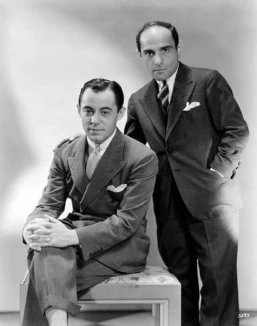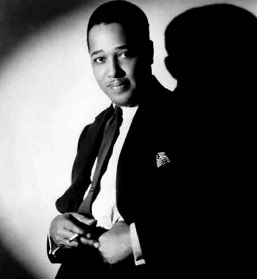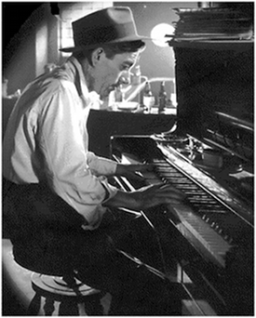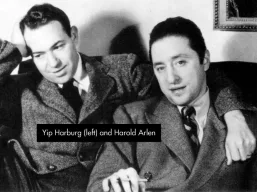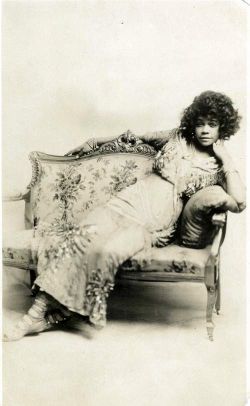One Morning in May
____________________________
One Morning in May (m. Hoagy Carmichael, w. Mitchell Parish)
The first recording of “One Morning in May” that I’m aware of is that by Hoagy Carmichael and his Orchestra in Chicago in October 1933, an instrumental recording.
Lanny Ross recorded the song in November 1933, possibly the first vocal recording, with orchestral accompaniment by an orchestra directed by Ray Sinatra. The Ross recording and a January 1934 recording by Emil Coleman and his Palais Royal Orchestra each feature a verse section that I haven’t heard in any other recordings of the song. In the Ross recording it falls as an interlude following the four sections of a 32-bar chorus, though the lyric of the fourth section isn’t sung until the section is repeated after the interlude. In the Coleman recording the verse section comes as a sort of coda near the end of the recording, which features the 32-bar chorus with vocals, then the full chorus repeated instrumentally, followed by the verse section/coda ending. In the Coleman recording, the lines of the verse go as follows:
Pale cheeks so soft and white
Where do you dream tonight?
Maybe we’ll meet again someday sweetheart
while the earlier Ross version has the same lines, except that the word “someday” is omitted in the third line. The same three lines, including “someday,” are seen on page 17 of the 1988 book Stardust, which evidently contains the libretto (book) of the 1987 Broadway musical Stardust, featuring songs with lyrics by Mitchell Parish.
A 16 November 1933 instrumental recording by Wayne King and his Orchestra was issued on (US) Brunswick 6735, c/w “Song of Surrender.”
In 1934 the song was recorded by numerous bands and orchestras, including those led by the following: Emil Coleman, Harry Roy, Roy Fox, Ray Noble (with vocal by Al Bowlly), Bert Ambrose, Jack Payne, and Geraldo (Gerald Walcan Bright), and by Marion Harris with an orchestra that I haven’t yet identified. These are all vocal versions. The list of 1934 recordings suggests that the song may have been more popular in the UK than in the US early on. I’ve omitted videos or audio files of all of the early vocal recordings, mainly because I find it an ordeal to listen to them.* However, a few later vocal recordings have been included. I’ve yet to discover any recordings of the song made during the years 1935-1951.
Some early vocal recordings:
- Lanny Ross with orchestra directed by Ray Sinatra – recorded on 27 November 1933; issued on Victor 24493, c/w “The Harbor of Home Sweet Home.”
- Emil Coleman and his Palais Royal Orchestra, vocal: Jerry Cooper — recorded in New York, New York on 11 January 1934; issued on Columbia 2877-D, c/w “On the Wrong Side of the Fence” — In the UK the same two sides were issued on Regal Zonophone MR 1282, under the name “The Broadway Bandits.”
- Harry Roy and his Orchestra (from the May Fair Hotel), w/ vocal refrain — recorded on 20 March 1934; issued in May 1934 on (UK) Parlophone R1812, c/w “Mama Don’t Want No Peas an’ Rice an’ Cocoanut Oil”
- Roy Fox and his Band, vocal: Denny Dennis — recorded on 26 March 1934; issued on (UK) Decca F3943 (F.3943). c/w “You Oughta Be in Pictures”
- Jack Payne and his Band, vocal: Billy Scott-Coomber — recorded in March 1934, according to RateYourMusic.com, and released in May 1934, according to 78rpmcommunity.com, on (UK) Rex 8147, c/w “Let’s Fall in Love”
- Ray Noble and his Orchestra, vocal: Al Bowlly — recorded on 5 April 1934, (HMV)
- Marion Harris with unidentified orchestral accompaniment – issued in April 1934 on (UK) Decca F.3954, b/w “Oo-oo-ooh! Honey (What You Do to Me)”
- Geraldo and his Sweet Music, with unidentified vocalist — 1934 Pathetone short film, identified at britishpathe.com as film ID#1096.14. The original is or was evidently part of the contents of canister PT 216.
________________________
Hoagy Carmichael and his Orchestra — recorded on 10 October 1933; issued on the 78 rpm single Victor 24505, b/w “Armful of Trouble,” B-side recorded by Don Bestor and his Orchestra
personnel (according to sources 1, 2, 3, 4):
Hoagy Carmichael – piano, Elvan ” Fuzzy” Combs (as J. Coombs) — alto sax, Fred Murray – trumpet, Bob Vollmer** – drums, unknown – clarinet, unknown – guitar, unknown – bass
.
Robert Farnon and his Orchestra — recorded on 26 June 1952; released in March 1953 on the LP Victor Schertzinger Suite / Hoagy Carmichael Suite, Decca Records LK 4055, (US) London Records LL 623
.
The Murray Arnold Quartet — from the 1956 album Overheard in a Cocktail Lounge, MGM Records E3457
.
The Octet of Max Albright — from the album Mood for Max, Motif Records ML502, release date unknown; album recorded in Los Angeles, CA, on 8, 16, and 23 November 1956 — also released on the album A Swingin’ Gig, Tampa Records TP 2 (color vinyl, 1957; black vinyl, 1958) — among members of the octet/session personnel are: Max Albright – drums, vibes, bells; Buddy Collette – alto sax, tenor sax, clarinet, flute; Gerald Wiggins – piano
.
.
Buddy Cole — theater pipe organ solo, from his 1957 LP Pipes, Pedals and Fidelity, (US) Columbia CL 1003 (Mono), and (US, Canada) Columbia CS 8065
.
George Shearing Quintet and Orchestra — from the 1957 album Black Satin, (US) Capitol Records T858 and Capitol T-858 (Mono), (UK) Capitol T 858 (Mono) — According to Discogs.com, stereo versions of the album weren’t released until 1959.
.
Benny Carter — from his 1959 album Aspects, (US) United Artists Records UAL 4017 (Mono), UAS 5017 (Stereo)
instrumentation on this track: Benny Carter – alto & tenor saxophone, Joe Comfort – bass, Shelly Manne – drums, Bobby Gibbons – guitar, Arnold Ross – piano, as well as two other tenor saxes, and a horn section including five trumpets and two trombones
(digitally remastered)
.
Pete Jolly Trio — from the 1965 album Too Much, Baby!, Columbia CL 2397 (Mono), CS 9197 (Stereo)
Pete Jolly – piano
Chuck Berghoffer – bass
Nicholas Martinis – drums
.
What would it have sounded like if Bobby Darin in his “new Sinatra” incarnation of the early ’60s had recorded “One Morning in May”? Perhaps something like the next recording on our list. Note that, as the album cover illustrates, when one is swinging as opposed to singing, a different color suit is worn, and the bow tie must be replaced by a necktie. Should you need any finger snapping practice, here comes your chance.
Frankie Randall — from the 1965 album Sings & Swings, RCA Victor LPM-2967
From the obit “Rat Pack singer Frankie Randall, Sinatra’s house pianist, dies at 76,” by David Colker, published at LATimes.com on 1 January 2015:
Randall is most closely identified, not only in his professional but also in his personal life, with Frank Sinatra. The leader of the Rat Pack first heard Randall in a New York club and helped him get a recording contract. And although the “most memorable” gig of Randall’s career was his first appearance on the “Tonight Show,” he told the Palm Springs Desert Sun in 2011, the “best bill” he ever appeared on was with Sinatra and Sammy Davis Jr. in Atlantic City.
Later in life, Randall became the unofficial house pianist at Sinatra’s Rancho Mirage home. Living nearby, he would walk to Sinatra’s house when summoned to play piano for informal gatherings that could go late into the night, sometimes with Sinatra singing. “He called me his favorite piano accompanist,” Randall told the New York Daily News in 2007.
video presently unavailable
_____________________
Art Van Damme Quintet — from the 1967 LP The Gentle Art of Art, (Germany) SABA SB 15 114 ST; also issued in the UK in 1968 on Polydor 583 713
Art Van Damme – accordion
Peter Witte – bass
Charly Antolini – drum
Freddie Rundquist – guitar
Heribert Thusek – vibraphone
.
Bert Kaempfert — from the 1969 album One Lonely Night, (Germany, UK) Polydor 184 313
.
Carrie Smith with the Loonis McGlohon Trio — recorded in Columbia, SC, in November 1976; released in 1994 on the album Fine & Mellow, Audiophile ACD-164 (see images above)
The sides of the album are titled, respectively, “Carrie Sings Billie Holiday” and “Carrie Sings Hoagy Carmichael.” The tracks on the A-side had previously been issued on the 1983 album Fine & Mellow, Audiophile AP-164. I’ve not been able to find any evidence to suggest that the eleven tracks on the B-side of ACD-164, the Carmichael songs, were previously released.
.
Jim Callum Jazz Band — from the 1990 CD album Hooray for Hoagy!, Audiophile Records ACD-251
.
Barbara Lea, Bob Dorough, Dick Sudhalter and others — from the 1994 album “Hoagy’s Children” In a Celebration of Hoagy Carmichael’s Songs, Volume One, Audiophile ACD-291 — The album is a partly a reissue of the 1983 album Hoagy’s Children – Songs Of Hoagy Carmichael, Audiophile AP-165, but it’s augmented by several more recently recorded tracks. Some of the newer tracks are from live performances in 1984-1985, and some are studio recordings from 1993. This track was recorded at Seltzer Sound in New York on 17 June 1993. There was no recording of “One Morning in May” on the 1983 album.
personnel on this track include the following:
Barbara Lea (vocal)
James Chirillo, Frank Vignola (guitar)
Bill Crow (bass)
Dick Sudhalter (trumpet or cornet, muted)
Eddie Locke (drums)
(incomplete track)
.
Bill Charlap Trio — from the album Stardust, Blue Note 7243 5 35985 2 5 (also Blue Note 35985); album recorded 6-8 September 2001 at The Hit Factory in NYC, and released in 2002
Bill Charlap – piano
Peter Washington – bass
Kenny Washington – drums
.
Paul Kuhn Trio — live performance, from the CD album Unforgettable Golden Jazz Classics, IN+OUT 77050 — According to the site jazzlists.com, the album was released in 2002. However there is certainly no consensus upon that date. Among other release dates for the album claimed by merchants and discographers are 2009, 2010, 2011, 2014, and 2016.
Paul Kuhn – piano
Martin Gjakonovski – bass
Willy Ketzer – drums
.
Randy Carmichael — piano solo, published on YouTube, 4 July 2008
The performer is the second son of Hoagy Carmichael. The video provider says:
After dinner, Randy Carmichael graciously performed at the home of Ed and Judy Thornberg in Richmond, Indiana.
.
Herbie Steward, Gene DiNovi, Dave Young, Yukio Kimura — from the LP One Morning in May, (Japan) Marshmallow Export MMEX-118LP, released on 21 January 2008
Herb Steward – tenor saxophone
Gene DiNovi – piano
Dave Young – bass
Yukio Kimura – drums
.
trio, featuring 二村希一(piano), 加藤泉(guitar), 横山裕(bass) — 10 November 2011, Tokyo
____________________________
* My objection to the early vocal recordings is based upon numerous factors, but one of the principal issues is the cloying, maudlin, and in some cases effete, vocal delivery that must be endured in listening to most of them, the Marion Harris vocal being somewhat of an exception. The lyric itself may be partly responsible for encouraging the dreary, drippy tones adopted for the majority of the 1933 and 1934 vocal recordings.
What’s wrong with the lyric?
1. The words don’t suit the music. The original recording by Hoagy Carmichael and his Orchestra is relentlessly upbeat. It’s a jaunty, joyous celebration of something, perhaps the beauties of spring, or maybe just the sheer joy of being alive. In contrast to the lyric written by Mitchell Parish, not one note in it suggests pining for love lost.
Similarly upbeat recordings, such as those by the Max Albright 8 (1956), Benny Carter (1959), Pete Jolly (1965), Frankie Randall (1965), Art Van Damme Quintet (1967), Bill Charlap Trio (2002), etc., demonstrate that “One Morning in May” is, or at least can be, quite naturally performed as a lighthearted, buoyant, and even jubilant number. You could have a vocalist recite the Parish words over such an arrangement, but if one isn’t careful to quickly downshift to a less ebullient mood at the right time — as Frankie Randall does the first time he sings “Though love smolders away to an ember” (but not the second time), and elsewhere (“Now that we’re apart,” “And dreams perish”) — then certain lines might seem inconsistent with the joyful swagger with which they’re delivered.
However, in his book Stardust Melody: The Life and Music of Hoagy Carmichael, (2009), Richard M. Sudhalter has a very different opinion than I regarding the marriage of words and music in this song. On page 158 the author says:
Music and lyric are matched perfectly, Parish’s imagery amplifying and illuminating Hoagy’s expansive melody. When the bridge, for example, tells us of “Kisses that came with the flame of springtime,” the melody line, appropriately, soars up a major sixth…
Sudhalter also notes on the same page that, after a “reunion” with Mitchell Parish produced the song, it was “cited by the composer ever after as his (and his mother’s) favorite among his own songs.”
2. The “rosary” line. “Kisses that came with the flame of springtime” are said to be “Precious to me like a rosary,” not “Precious to me as a rosary,” so while it’s not necessarily an assessment of the comparative values of flaming springtime kisses and a rosary, the two things are apparently considered to be similarly precious. If I were of a religious bent, then wouldn’t a lyric that compares the preciousness of a set of prayers, or a set of beads that represent prayers, to that of “kisses that came with the flame of springtime” seem highly blasphemous?
3. Hoagy Carmichael recorded numerous vocal versions of some of the songs he wrote or co-wrote. For example, he recorded at last four vocal versions of “Baltimore Oriole,” and multiple vocal versions of both “Stardust,” for which Parish contributed the lyric, and “Lazybones.” Not only did Carmichael not record an early vocal version of “One Morning in May” but he may never have recorded one. I haven’t discovered a single vocal recording of the song by Hoagy.
Incidentally, on page 159 Sudhalter suggests that it might have been ill-advised for Carmichael with a “quintet of old Indiana pals” to record the song as an instrumental, supporting the opinion with the suggestion that the trumpet player’s ability to perform had been adversely affected by alcohol consumption during the session.
** However, according to Sudhalter in Stardust Melody, p. 159, the drummer was Andy Van Sickle.
















